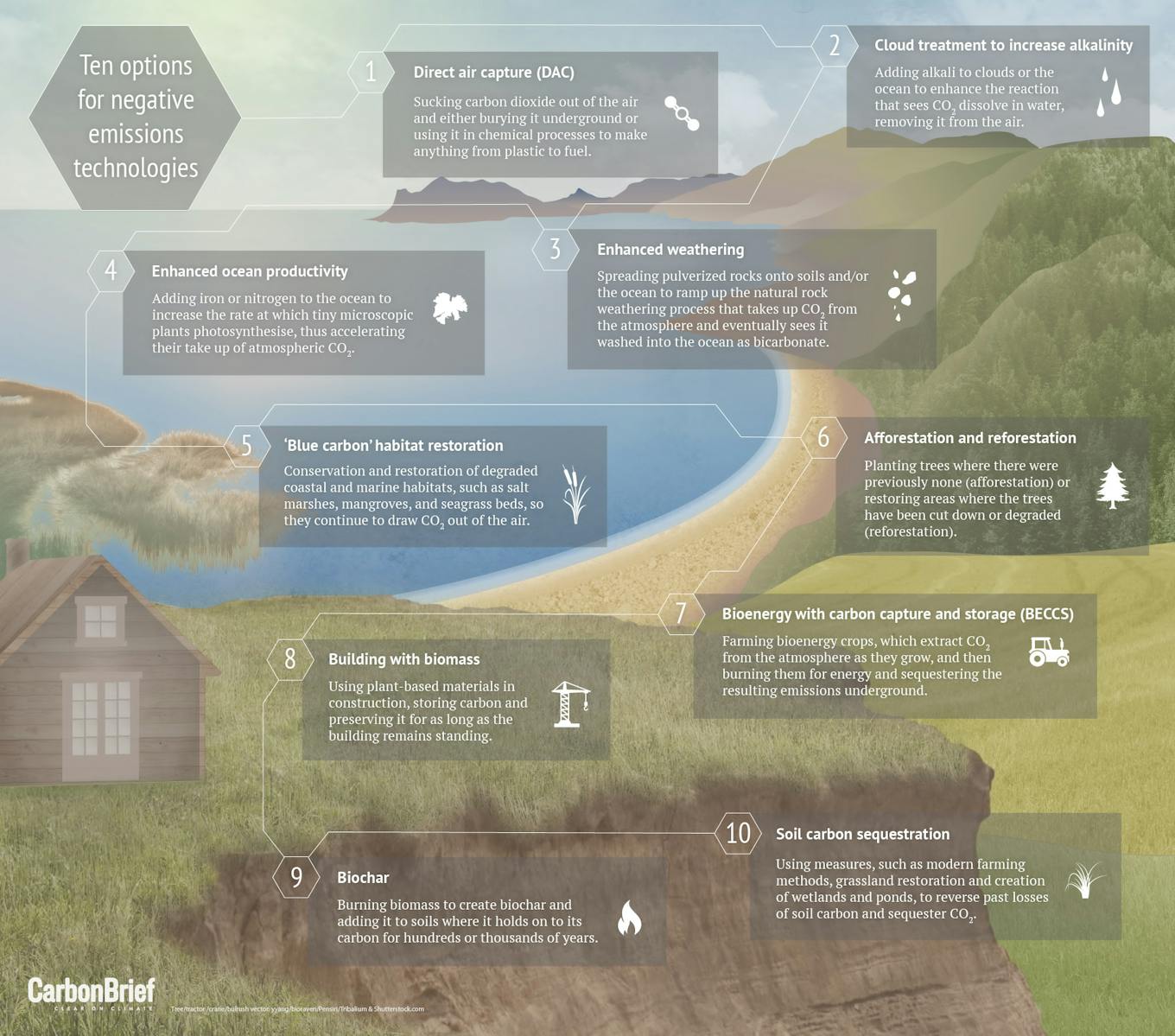The Paris Agreement, adopted at the COP21 climate talks in December, sets out a global aim to limit average global surface temperatures to “well below 2C” above pre-industrial levels. It adds that there should be “efforts” to limit it to 1.5C.
But as countries across the world move towards signing and ratifying the agreement, there remains the key question of how these ambitious targets can be met.
A study published last year warned that all the scenarios for keeping global temperature rise to 2C require “negative emissions” – removing CO2 from the atmosphere and storing it on land, underground or in the oceans.
Although plenty of negative emissions technologies have been proposed, none are ready to be rolled out around the world, or, in some cases, even demonstrated to work at scale.
Kicking off a week-long series on negative emissions technologies (NETs), Carbon Brief takes a look at the many and varied options. Tomorrow, we will publish the views of a wide range of experts who have examined the feasibility of NETs.
Net-zero emissions
The Paris Agreement was a “historic moment and quite a fantastic result”, says Prof Joanna Haigh, co-director of the Grantham Institute for Climate Change and Environment at Imperial College.
But, as she explains to Carbon Brief, now comes the difficult bit: “It’s fantastic that they’ve agreed, but how to do it is now the big issue. The main way we’re going to try to do it, of course, is to reduce carbon emitted into the atmosphere, for example, by using more renewable energy sources and green technology more generally. But there may be sources of carbon that we can’t avoid.”
If we can’t stop carbon emissions altogether, then we need to counterbalance them by taking some CO2 back out of the atmosphere, says Haigh.
This is necessary in order to achieve net-zero emissions, she says: “To get to net-zero emissions, we need to have some of what are called “negative emissions” technologies, or things which will suck the CO2 out of the air to compensate for the ongoing release.”
NETs take more CO2 out of the atmosphere than they put in. No one single technology can solve climate change, but many have been proposed that could contribute to reducing atmospheric CO2. Some consider the notion to be a form of geoengineering, and sometimes refer to it as “CDR” (carbon dioxide removal).
Carbon Brief takes a closer look – in alphabetic order – at 10 of the most frequently proposed NETs, which you can also see in the infographic here:

Infographic: Carbon Brief
- Afforestation and reforestation
- Biochar
- BECCS
- ‘Blue carbon’ habitat restoration
- Building with biomass
- Cloud or ocean treatment with alkali
- Direct air capture
- Enhanced ocean productivity
- Enhanced weathering
- Soil carbon sequestration
Afforestation and reforestation
Afforestation means planting trees where there were previously none. Reforestation means restoring areas where the trees have been cut down or degraded. Because trees take up CO2 from the atmosphere as they grow, planting more trees means boosting how much CO2 forests absorb and store. As a method of removing CO2 from the atmosphere, this is one of the most feasible options, although it still has drawbacks and uncertainties.
Reforestation is almost universally desirable in its own right, particularly if it means re-planting native trees, and is already widely recognised and used to tackle climate change. Many countries are already practising it, such as Brazil, which has pledged to restore 12m hectares of forest. The UN’s Clean Development Mechanism provides a financial incentive for countries to increase their forest stocks.
Estimates suggest that afforestation and reforestation can sequester CO2 at a rate of 3.7 tonnes per hectare per year, and comes with an associated cost of $20-100 per tonne.
One potential obstacle to afforestation is land availability and suitability. This depends on a range of factors, including global population, diet, the efficiency and intensity of agriculture, and rising competition from bioenergy. Planting vast areas of forests could also cause complex changes in cloud cover, reflectivity, and the soil-water balance. All of these could also have an impact on the Earth’s climate.
Biochar
Biochar is the name given to charcoal that is added to soils rather than burned as a fuel. The charcoal is produced by burning biomass, such as wood, crop wastes and manure, while cutting off the supply of oxygen. This process is known as pyrolysis.
The carbon in the resulting biochar is very slow to break down. This means the carbon it absorbed from the atmosphere while it was mere biomass is locked up for – potentially – hundreds or even thousands of years.
This story was originally published by Carbon Brief under Creative Commons. To continue reading the rest of the feature, click here.












